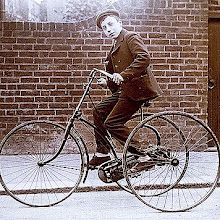This is a human powered vehicle that I have been designing (mostly in my head) for the past 5 or so years. A Provisional Patent Application has been filed with the US Patent and Trademark Office and now thanks to my dads' help I can say it is now Patent Pending. I love coming up with new ideas. I spend a lot of my time thinking of ways to improve human powered vehicles, energy storage systems, etc.. These drawings were done to US patent Office standards with Autocad in 3D I am now learning how to use Solidworks to do my drawings and virtual prototyping. Also, these drawings are not at all the final design. They represent the concept only for the purpose of the patent application. And to help you in your grok process.

The way this vehicle works is by moving your legs back and forth. A cable wraps around the rear hub that is attached at the forward end to the frame or some other relatively fixed location on the vehicle... So when you push your leg back, the cable unravels and spins the wheel forward.

If you ever had a gyroscope as a kid you can see how similar this kind of principle works. The rear wheels are like gyroscopes being pulled while the string is held in a fixed position. Figure 1A is an isometric view, 1B is the front view, 1C is the side view, 1D is the top view, 1E is a detailed sketch of the rear.

 If you ever had a gyroscope as a kid you can see how similar this kind of principle works. The rear wheels are like gyroscopes being pulled while the string is held in a fixed position. Figure 1A is an isometric view, 1B is the front view, 1C is the side view, 1D is the top view, 1E is a detailed sketch of the rear.
If you ever had a gyroscope as a kid you can see how similar this kind of principle works. The rear wheels are like gyroscopes being pulled while the string is held in a fixed position. Figure 1A is an isometric view, 1B is the front view, 1C is the side view, 1D is the top view, 1E is a detailed sketch of the rear.










